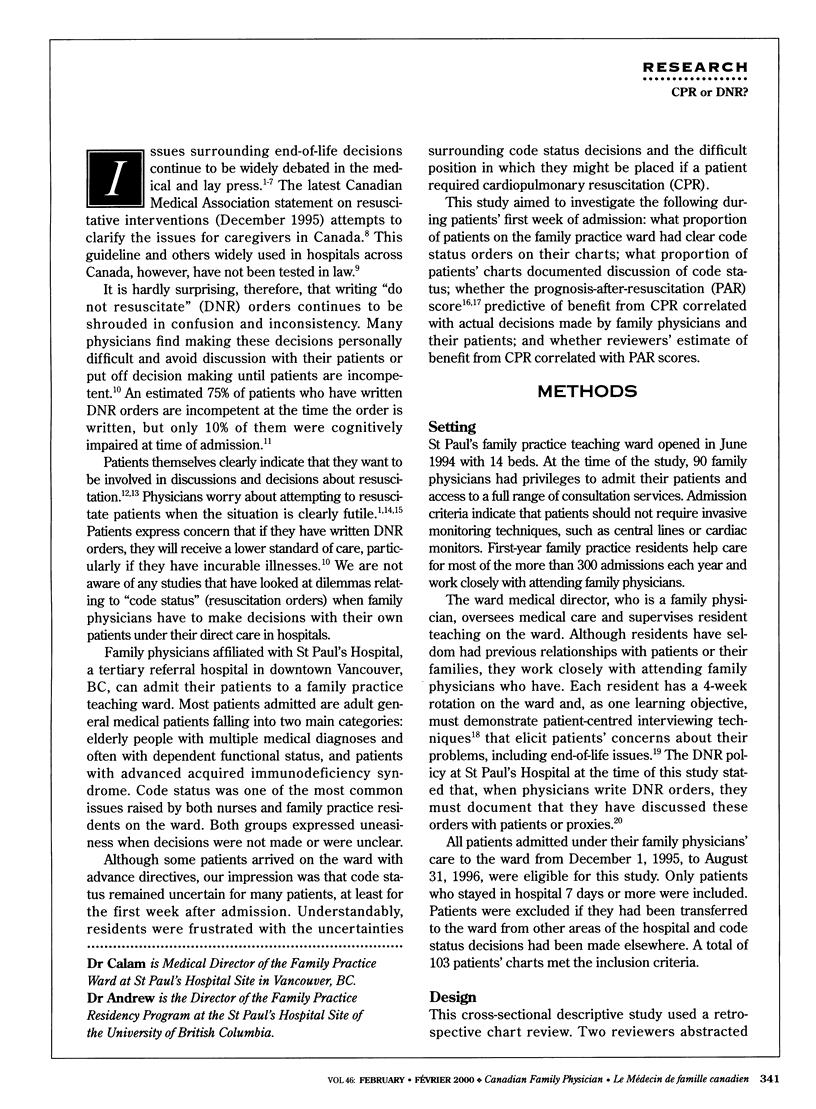Abstract
OBJECTIVE: To determine the proportion of patients on a family practice ward who had "code status" orders and end-of-life discussions documented on their charts in the first week of admission. To examine the correlation between a tool predicting the likelihood of benefit from cardiopulmonary resuscitation (CPR) and actual end-of-life decisions made by family physicians and their patients. DESIGN: Cross-sectional descriptive study using a retrospective chart review. SETTING: A 14-bed teaching ward where family physicians admit and manage their own patients in an urban tertiary care teaching hospital. PARTICIPANTS: Patients admitted to the ward for 7 or more days between December 1, 1995, and August 31, 1996. MAIN OUTCOME MEASURES: Frequency of documented "do not resuscitate" (DNR) or "full code" orders and documented end-of-life discussions. Prognosis-after-resuscitation (PAR) score. RESULTS: In the 103 charts reviewed, code status orders were entered within 7 days for 60 patients (58%); 31 were DNR, and 29 were full code. Discussion of code status was documented in 25% of charts. The PAR score for 40% of patients was higher than 5, indicating they were unlikely to survive to discharge from hospital should they require CPR. There was a significant association between PAR scores done retrospectively and actual code status decisions made by attending family physicians (P < .005). CONCLUSIONS: End-of-life discussions and decisions were not fully documented in patients' charts, even though patients were being cared for in hospital by their family physicians. A PAR score obtained during the first week of admission could assist physicians in discussing end-of-life orders with their patients.
Full text
PDF






Selected References
These references are in PubMed. This may not be the complete list of references from this article.
- Buckman R., Senn J. Eligibility for CPR: is every death a cardiac arrest? CMAJ. 1989 May 1;140(9):1068–1069. [PMC free article] [PubMed] [Google Scholar]
- Ebell M. H. Practical guidelines for do-not-resuscitate orders. Am Fam Physician. 1994 Nov 1;50(6):1293-9, 1303-4. [PubMed] [Google Scholar]
- Ebell M. H. Prearrest predictors of survival following in-hospital cardiopulmonary resuscitation: a meta-analysis. J Fam Pract. 1992 May;34(5):551–558. [PubMed] [Google Scholar]
- Ginn D., Zitner D. Cardiopulmonary resuscitation. Not for all terminally ill patients. Can Fam Physician. 1995 Apr;41:649-52, 655-7. [PMC free article] [PubMed] [Google Scholar]
- Gordon M., Cheung M. DNR policy and CPR practice in geriatric long-term institutional care. CMAJ. 1991 Aug 1;145(3):209–212. [PMC free article] [PubMed] [Google Scholar]
- Hill M. E., MacQuillan G., Forsyth M., Heath D. A. Cardiopulmonary resuscitation: who makes the decision? BMJ. 1994 Jun 25;308(6945):1677–1677. doi: 10.1136/bmj.308.6945.1677. [DOI] [PMC free article] [PubMed] [Google Scholar]
- Keyserlingk Edward W. Second-generation advance directives: will reforming the law improve the practice? Humane Med. 1993 Jan;9(1):57–63. [PubMed] [Google Scholar]
- Molloy D. W., Alemayehu E., Roberts R. Reliability of a Standardized Mini-Mental State Examination compared with the traditional Mini-Mental State Examination. Am J Psychiatry. 1991 Jan;148(1):102–105. doi: 10.1176/ajp.148.1.102. [DOI] [PubMed] [Google Scholar]
- Morgan R., King D., Prajapati C., Rowe J. Views of elderly patients and their relatives on cardiopulmonary resuscitation. BMJ. 1994 Jun 25;308(6945):1677–1678. doi: 10.1136/bmj.308.6945.1677a. [DOI] [PMC free article] [PubMed] [Google Scholar]
- Morris B. A., Van Niman S. E., Perlin T., Lucic K. S., Vieth J., Agricola K., McMurry M. K. Health care professionals' accuracy in predicting patients' preferred code status. J Fam Pract. 1995 Jan;40(1):41–44. [PubMed] [Google Scholar]
- Murphy D. J., Burrows D., Santilli S., Kemp A. W., Tenner S., Kreling B., Teno J. The influence of the probability of survival on patients' preferences regarding cardiopulmonary resuscitation. N Engl J Med. 1994 Feb 24;330(8):545–549. doi: 10.1056/NEJM199402243300807. [DOI] [PubMed] [Google Scholar]
- O'Keeffe S., Ebell M. H. Prediction of failure to survive following in-hospital cardiopulmonary resuscitation: comparison of two predictive instruments. Resuscitation. 1994 Jul;28(1):21–25. doi: 10.1016/0300-9572(94)90050-7. [DOI] [PubMed] [Google Scholar]
- Senn J. S. Writing "no-CPR" orders: must resuscitation always be offered? CMAJ. 1994 Oct 15;151(8):1125–1128. [PMC free article] [PubMed] [Google Scholar]
- Stewart K. Discussing cardiopulmonary resuscitation with patients and relatives. Postgrad Med J. 1995 Oct;71(840):585–589. doi: 10.1136/pgmj.71.840.585. [DOI] [PMC free article] [PubMed] [Google Scholar]
- Varon J., Fromm R. E., Jr In-hospital resuscitation among the elderly: substantial survival to hospital discharge. Am J Emerg Med. 1996 Mar;14(2):130–132. doi: 10.1016/S0735-6757(96)90118-7. [DOI] [PubMed] [Google Scholar]
- Ventres W., Nichter M., Reed R., Frankel R. Do-not-resuscitate discussions: a qualitative analysis. Fam Pract Res J. 1992 Jun;12(2):157–169. [PubMed] [Google Scholar]
- Youngner S. J. Who defines futility? JAMA. 1988 Oct 14;260(14):2094–2095. [PubMed] [Google Scholar]


